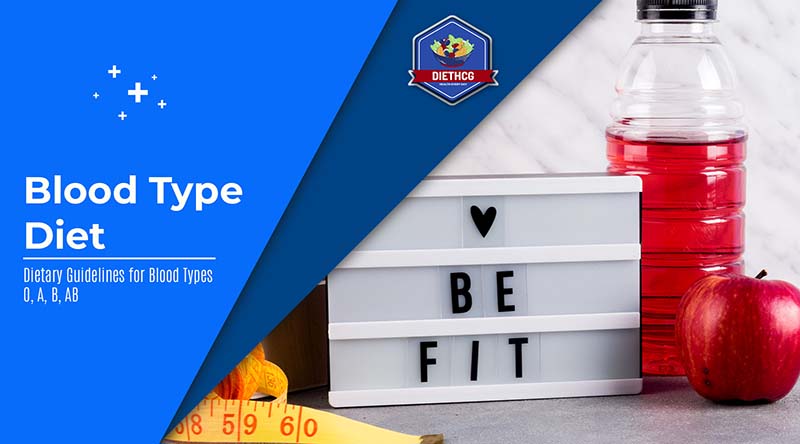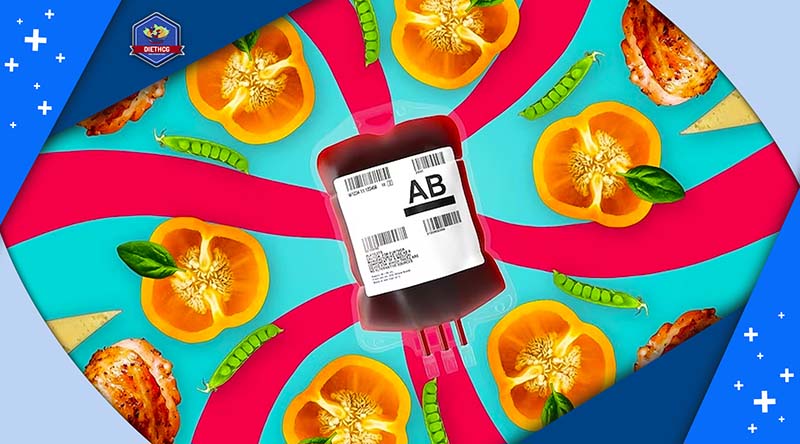The blood type diet shows that your dietary needs are closely related to blood types A, B, O, AB. Despite its popularity, this diet lacks significant scientific support for its supposed health benefits. Continue exploring the blood type diet with DietHCG’s article to determine the right diet for your nutritional needs.

1. What Is the Blood Type Diet?
The blood type diet is a dietary approach based on the concept that your blood type dictates the optimal foods and exercises for your health. This theory was originally developed by Peter D’Adamo, a naturopathic physician.
The central idea of this diet revolves around lectins, a type of protein found in foods. It suggests that consuming foods containing lectins incompatible with your blood type can lead to problems like blood cell clumping (agglutination), potentially causing health issues such as heart disease, kidney disease, or cancer.
Dr. D’Adamo asserts that blood types have evolved differently in various societies, each with its ideal dietary pattern:
- Type A, referred to as Agrarian, supposedly benefits from a predominantly vegetarian diet.
- Type B, termed Nomadic, is said to thrive on a diet rich in dairy products.
- Type AB, known as Enigma, is suggested to do well with a blend of Type A and Type B diets.
- Type O, known as Hunter, is believed to be the oldest blood type and is recommended to follow a diet high in animal protein.

2. How Does the Blood Type Diet Work?
Your blood type is determined by the blood types of your biological parents and is present from birth. There are four primary blood groups, characterized by the presence or absence of two antigens, A and B, on the surface of your red blood cells. For instance, having both antigens results in AB blood type, while the absence of both yields O blood type.
According to D’Adamo, the antigens determining your blood type also exist in other parts of your body, including your digestive system. This, he claims, leads to a chemical reaction between the foods you consume and your blood type.
Additionally, individuals with different blood types harbor distinct gut bacteria, a trait that D’Adamo traces back to our ancient ancestors. He posits that the earliest humans possessed type O blood and subsisted on a diet low in carbohydrates and high in protein due to their hunter-gatherer lifestyle. Those with type A blood, on the other hand, are theorized to have descended from agricultural societies, thus advocating for a diet rich in vegetables. Meanwhile, type B individuals are believed to have evolved from nomadic tribes with diets abundant in meat and dairy, implying that they can digest fat more efficiently.
D’Adamo suggests that consuming foods prevalent during the era when your blood type originated may enhance your body’s ability to digest food effectively.
3. How to Start the Blood Type Diet?
Before starting the blood type diet, determining your blood type is essential. If you’re unsure of your blood type, consider undergoing a blood test. You can arrange this through your healthcare provider, or alternatively, learn your blood type during a blood donation session.
Each individual also possesses an Rh factor, which identifies your blood as either Rh positive (+) or Rh negative (-). While following the blood type diet, the presence or absence of the Rh factor is less critical than knowing whether you are type O, A, B, or AB.
Knowing your blood type allows you to tailor your diet accordingly, focusing on foods that are most beneficial for you. You have the flexibility to start the diet immediately or gradually integrate the recommended foods into your meals by replacing items in your pantry with those that align better with your blood type.
4. Foods to Eat on the Blood Type Diet
The blood type diet recommends specific foods tailored to each blood type group:
4.1. Blood type O diet
- Emphasizes a high-protein diet with lean meat, poultry, fish, fruits, and vegetables.
- Recommends limiting grains, beans, and dairy.
- For weight loss, opt for seafood, kelp, red meat, broccoli, spinach, and olive oil.
- Supplements may be suggested to address common issues associated with type O blood, such as digestive troubles.

4.2. Blood type A diet
- Advocates a vegetarian diet rich in fruits, vegetables, tofu, beans, legumes, and whole grains.
- Preferably organic and fresh produce, as type A individuals are believed to have a sensitive immune system.
- Foods like vegetables, pineapple, olive oil, and soy are conducive to weight loss, while dairy, wheat, corn, and kidney beans may contribute to weight gain.

4.3. Blood type B diet
- Encourages a mixed diet incorporating meat, fruit, dairy, seafood, and grains.
- Advises against consuming corn, wheat, buckwheat, lentils, tomatoes, peanuts, sesame seeds, and chicken.
- Emphasizes green vegetables, eggs, select meats, and low-fat dairy products.

4.4. Blood type AB diet
- Focuses on foods such as tofu, seafood, dairy, and green vegetables.
- Individuals with type AB blood are often suggested to have low stomach acid and are advised to avoid caffeine, alcohol, and smoked or cured meats.
- Certain dairy products like yogurt and kefir are recommended for this group.

5. Pros and Cons of the Blood Type Diet
As with any dietary approach, the blood type diet has its share of advantages and disadvantages, which may vary depending on individual preferences and lifestyle factors.
5.1. Pros
- Encourages exercise: The Blood Type Diet promotes regular exercise, which, when combined with a healthy diet, can aid in weight loss and weight management. However, there’s a lack of scientific evidence supporting the effectiveness of this diet for weight loss specifically.
- Emphasizes whole foods: Each blood type plan emphasizes selecting whole foods over processed options, a commendable aspect for overall health. This emphasis on whole foods can provide a wide variety of nutrient-rich options, facilitating adherence to the diet for some individuals.
- Can be a well-rounded choice: While each blood type has its own dietary restrictions, the program isn’t excessively low in calories or overly restrictive. Plans for blood types B and AB offer a more balanced approach, potentially meeting most nutritional needs. However, restrictions in diets for types A and O may not be suitable for long-term adherence for many individuals.
5.2. Cons
- Not effective: Despite claims, there’s insufficient scientific evidence to support the effectiveness of the Blood Type Diet as a weight-loss strategy.
- Not based on science: The concept of eating according to blood type lacks scientific foundation. Research on the Blood Type Diet is limited, with studies showing mixed results, regardless of blood type.
- Requires unsubstantiated supplements: Proponents of the diet recommend supplements to meet nutritional needs, but these are not a substitute for a balanced diet and lack scientific backing.
- Can be restrictive: Diets for blood types A and O are restrictive, raising concerns about potential nutrient deficiencies. Restriction of certain healthy food groups may pose challenges in meeting essential nutrient requirements.
- Not backed by evidence: Reviews of research on the Blood Type Diet have found no conclusive evidence supporting its health claims or cardiometabolic benefits.
6. What Our Experts Say About the Blood Type Diet?
While the blood type diet has garnered attention for its unique approach to nutrition based on one’s blood type, Kathleen Zelman, MPH, RDN, LD, a registered dietitian nutritionist, asserts that the scientific foundation of this diet is lacking. She describes it as a gimmick aimed at promoting healthier eating habits without scientific validation to support the necessity of aligning diet with blood type.
Zelman acknowledges that the diet’s emphasis on a plant-based, nutrient-rich regimen has merits, as demonstrated by a 2014 study indicating health improvements in adults who followed the type A diet recommendations. These benefits, however, were not exclusive to individuals with type A blood, suggesting the diet’s positive effects are universal rather than blood-type specific.
The diet promotes the consumption of high-quality foods, abundant fruits and vegetables, fiber, vitamins, minerals, lean proteins, and foods low in saturated fats. Such a diet naturally reduces calorie intake and cuts out added sugars, which can lead to weight loss.
However, strictly adhering to dietary recommendations based solely on blood type may not yield the most beneficial results for everyone. For instance, the type B diet’s higher saturated fat content could increase the risk of heart disease, contrary to the diet’s healthier options highlighted in other blood type recommendations.

Addressing specific health conditions, Zelman points out that the blood type diet does not cater to individual health issues like cardiovascular disease or diabetes. She suggests that although modifications to the diet could enhance health, these adjustments are not related to one’s blood type.
Zelman strongly recommends consulting with healthcare professionals or dietitians before adopting the blood type diet or any specialized eating plan.
Concerns also arise with the dietary exclusions recommended by the diet, such as the unnecessary elimination of eggplant and other foods containing lectins, like beans and whole grains, which are otherwise nutritious. She criticizes the diet’s narrow view on processed foods, explaining that not all processed foods are detrimental; some, like milk and wheat, undergo processing for safety and digestibility.
Moreover, Zelman notes that opting for organic produce, while ideal, is not essential. The priority should be increasing the intake of fruits and vegetables, regardless of their organic status.
Regarding children and the blood type diet, Zelman advises caution. Strict adherence could complicate providing a balanced diet, especially concerning dairy products crucial for children’s growth and bone health. She advocates for a more flexible approach to dieting that aligns with general health guidelines rather than the restrictive framework of the blood type diet. This adaptation would essentially shift the diet toward a universally healthy eating plan recommended by major health organizations.
7. Tips for Following the Blood Type Diet
Here are some practical tips for effectively following the blood type diet:
- Identify your blood type: Understanding your blood type is the foundation of the Blood Type Diet, as each type requires a tailored dietary approach.
- Adhere to your blood type’s diet plan: Each blood type has a specific dietary regimen. For instance, individuals with blood type O, deemed as “hunters,” should prioritize a diet rich in meat, while being dairy and grain-free.
- Be mindful of food choices: While no foods are strictly off-limits, certain foods are more beneficial for specific blood types. For example, those with blood type A should limit meat consumption and focus on fruits, vegetables, beans, and whole grains.
- Consider supplementation: D’Adamo recommends supplements tailored to each blood type, such as multivitamins, multiminerals, lectin blockers, and probiotic/prebiotic blends.
- Optimize mealtime habits: Avoid drinking water or other beverages during meals to prevent dilution of natural digestive enzymes, as suggested by the Blood Type Diet.
- Prioritize whole foods: Embrace whole, minimally processed foods while minimizing the intake of processed options, aligning with the diet’s emphasis on wholesome eating.
- Explore diverse recipes: Experiment with various recipes tailored to your blood type, utilizing online resources like Weight Watchers, which offer a plethora of diet-specific recipes.
- Maintain a goals journal: Keep track of how different foods affect your well-being and monitor your progress toward achieving health objectives through journaling. This can provide valuable insights into your dietary preferences and overall health journey.
8. Conclusion
In conclusion, the blood type diet suggests that optimal foods vary based on individual blood types, reflecting ancestral dietary patterns. However, despite its widespread popularity, there remains a lack of substantial scientific evidence to support the diet’s purported benefits.
As with any dietary approach, what works best for one person may not be suitable for another. While some individuals may thrive on plant-based diets like the type A regimen, others may fare better with diets rich in animal proteins, as recommended for type O.
Seek guidance from a healthcare professional when determining the most appropriate dietary options for your individual needs. They can offer personalized advice and support you in developing a suitable nutrition plan to effectively support your health and well-being.


